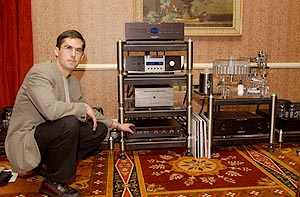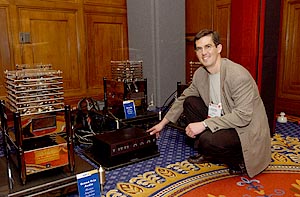 |
|||||||||||||
| Which gets us to Level-3. Our all-out, no-holds-barred assault on the flat-out best acoustical environment we can achieve with the budget and space you provide us with. And most of our Level-3 projects indeed are that, where people are prepared to utterly gut a room; build out a basement/garage/attic where the sound room isn't predefined by boundaries; or do additions and new construction. In most of those, the client wants the room to look attractive but doesn't object if it looks like a recording studio - like this one. Conversely, Jacob's space wouldn't work well if it had to double up as a family room. [Cracks up.] But we could design an all-out listening/living room with zero concessions to appearance and, in fact, routinely do so. |
|||||||||||||
 |
You see, this is one of the tiresome myths of audio: Acoustics are ugly. Show Jacob's resonators to most people and ask them how they'd like them in their living room. "I don't think so" will be the reply. We of course know how to design the same functionality into far more stealthy devices -- particularly for new construction -- to have it all disappear, completely. But in general, Level-3 projects tend to be dedicated listening rooms or home theaters, designed for that one purpose and one purpose only, and to get the sonic benefit at its maximum level and without compromise. |
||||||||||||
| Now, we did design a Level-2 room in a traditional home where the client intended to remain for another 3 years. He wanted good but invisible acoustics since he later was going to put the house on the market. We performed most the corrective acoustic measures in a coffered ceiling, with plenty of molding and lattice detailing to where you'd never know what we did. Speaking of ceiling. Tell us about your patent-pending array which you also installed for Jacob. We use slanted boards and absorptive material between the ceiling joists to create effective diffusion down to 200-250Hz. It's extraordinarily effective for rooms like this where we have limited ceiling height but very tall speakers that would otherwise turn the ceiling into the predominant room boundary. We couldn't really put anything on the ceiling since that would lower it only further. Still, it would be a grave mistake to not treat this large surface at all. The ideal solution then is to work in the ceiling, then trim it out with the kind of fabric that matches the client's decor. Say I had an existing 14' x 20' x 10' room and wanted to turn its acoustics into a stellar listening room. What would I have to financially commit to? Okay, let's talk money. Level-1 and 1+ are $900/$1350 respectively. Level-2 is $1,950. These services are diagnostic in nature, i.e. what they yield for the client is a precisely mapped, corrective remedy plan which still requires implementation. Level-3, with travel, time and materials, is invoiced at $165/hr and usually comes to $7,000 - $10,000 for our participation. Here again you have to add contractor's labor and materials to implement whatever structural changes, additions and treatment building blocks our blueprints specify. To break down how the costs for Level-3 accrue, consider that we usually come to the client's site three times. There's the first assessment and preliminary acoustic measurements, with meetings with the HVAC [heating/vent/air-conditioning] contractor and architect and an in-depth consultation with the client to work up the concept. Cooperation with the HVAC contractor is essential, to isolate heating and air-conditioning ducts such as to eliminate vent rattles, audible motor intrusion and bi-directional sound leakage. After delivering the schematics and blueprints, the client might need to meet with a building inspector and obtain the necessary permits, depending on whether it's new construction or retro-fit. The first visit is followed by our mid-project inspection of structural progress to assure that the client's contractor works to our actual plans without improvisation. As you can tell, many of our elements and the ceiling array fall outside a general contractor's standard list of jobs, Hence it's vital that we verify his work before it's permanently hidden from view. |
|||||||||||||
|
|
|||||||||||||
 |
|||||||||||||
But we routinely provide remote assistance for contractors who call in from the job to obtain our input or help. The more questions we get, the smoother the project will go. If I haven't received questions prior to my midpoint inspection? I know I'll have issues to contend with. [Cracks up again.] But that will always be at the builder's, not client's expense. After all, the builder was contracted not to be creative but follow orders - or, in our case, blueprints and drawings. After the third visit, we design the last tuning elements based on the on-site measurements of the otherwise finalized room. Once the client is happily listening to music, our job is done. Now explain to us this measuring kit of yours. What are we dealing with here? Minus my laptop computer, this little black case contains the other half of our standard tool kit. There's two CDs for the ETF and BARE software calibrations we employ and the drivers for the 24/96 U24 sound card. There's an elctret condenser microphone and preamp which we import from Germany. They're serialized, with an associated calibration file. We use a Radio Shack analog SPL meter to get a relative SPL level but don't use that for any critical measurements. Then there's the requisite cables and patch cords, all properly labeled and custom-made for us. All our dealers have an identical kit to this and have been trained on how to properly use it, to forward their measurements to our headquarters. Based on the dimensional drawings, we tell our dealers exactly where to take the measurements and where to place the microphone. We do not use spatial averaging unless we do it manually. If you input multiple data into the computer and let the program average, it masks important information. We look at all the measurements manually to observe deviations that suggest area-specific problems in particular portions of the room. What kind of reverberation times do you go after? We use RT-60 as our benchmark but it's not what I would call 'reverberation time' in the classical sense. We think of it more as the reflection time required to see a 60dB attenuation. After all, we're not working in a truly diffuse soundfield which would require far greater dimensions than you'd ever find in a home environment. We've learned that something between 35-40ms is ideal. Close to the 40ms time line creates more ambiance and nicer imaging at the expensive of some pinpoint accuracy. Other listeners prefer shorter reverberation times for a slightly drier sound that will unveil more inner detail. That's simply a function of how much direct versus reflected sound you get. Our rooms can be adjusted according to listener preference which is why we go through the initial interview process to learn what the client favors. A nearfield listener will require shorter RT-60 times than a farfield proponent. But below 35ms, things start to become very dry and sterile. It's what some recording studios go after. Mind you, not all, as some engineers want to be in an environment that more closely approaches that of the end user - but some will drop their RT-60 to 25ms. What would that time be in an untreated, 20' x 25' x10' living room? Depending on the room, it could be double or triple from what you'd want in a dedicated listening room. How about a modern house with floor-to-ceiling glass, wooden floors and lots of reflective surfaces? |
|||||||||||||
| That's a tough one. We do work with various types of window treatments that will introduce absorptive elements which need to be engaged during critical listening sessions. But we've run into a particular scenario multiple times where the speakers have to go on the windowless north wall, the east wall is solid glass and the west wall opens up into the kitchen. That's a real bear to wrestle down. Glass is easier to deal with when it's symmetrical in its use relative to the listening axis. If it's behind the speaker or the listener, window treatments become vital but effective - and most clients will be agreeable to closing these blinds or curtains while listening. | |||||||||||||
 |
|||||||||||||
We like using the Hunter-Douglas honey-comb shades and wooden blinds. In combination, they provide enough absorption from the ringing of the glass, with some diffusion from the blinds, to perform quite well. Naturally, the propensity of glass to leak low frequencies is something that cannot be accounted for easily. We'll address some of it by bringing the other frequency bands down in output, to balance against the bass loss and create a pleasing tonal balance. You always ask yourself what is the best you can do given the constraints you're operating within. And while perfection may remain elusive in certain problematic rooms, the amount of improvement post-installation over what was there before can still be very drastic and stunning. With new construction, we specify special laminate glass that doesn't leak bass like regular glass and is routinely used in recording studios. It also assists in sound isolation to and from the outside. Let's get back to how a prospective Level-2 client would work with you. Since you need the physical on-site measurement, it requires him to have a dealer in his territory, correct? Theoretically yes, but practically, if there's no dealer yet in his area, we can contract with one of the regional calibrators certified through Home Acoustic Alliance which covers pretty much every state. What is the cost of course attendance for a prospective Rives Audio dealer whom you'd naturally prefer to be certified in HAA's basic acoustics course? I'll have to check but believe it's about $1,000. It's a very worthwhile investment for any dealer to make, even if he weren't interested in becoming our dealer. Do you currently have dealers who sport a Rives Audio-designed listening room on their premises? By December 1, we should have four completed: Creative Technologies in Massachusetts; Fidelis Audio in New Hampshire; Ghost Fighters Home Theater in Illinois; and Sound Pursuit in Singapore. |
|||||||||||||
 |
 |
||||||||||||
 |
|||||||||||||